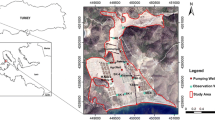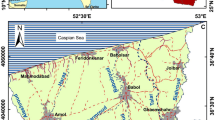Abstract
Seawater intrusion in coastal agricultural areas due to groundwater abstraction is a major environmental problem along the northeastern coast of Australia. Management options are being explored using numerical modelling, however, questions remain concerning the appropriate level of sophistication in models, choice of seaward boundary conditions, and how to accommodate heterogeneity and data uncertainty. The choice of seaward boundary condition is important since it affects the amount of salt transported into the aquifers and forms the focus of the present study. The impact of this boundary condition is illustrated for the seawater-intrusion problem in the Gooburrum aquifers, which occur within Tertiary sedimentary strata. A two-dimensional variable-density groundwater and solute-transport model was constructed using the computer code 2DFEMFAT (Cheng et al. 1998). The code was tested against an experiment for a steady-state freshwater-saltwater interface and against the Elder (Elder 1967) free-convection problem. Numerical simulations show that the imposition of the commonly-used equivalent hydrostatic freshwater heads, combined with a constant salt concentration at the seaward boundary, results in overestimated seawater intrusion in the lower Gooburrum aquifer. Since the imposition of this boundary condition allows water flow across the boundary, which subsequently takes salt into the aquifer, a careful check is essential to estimate whether too much mass of salt is introduced.
Résumé
Investigations numériques de l’intrusion d’eau de mer à Gooburrum, Bundaberg, Queensland. L’intrusion d’eau salée due au captage d’eau souterraine dans les régions agricoles situées le long de la côte Nord-Est de l’Australie est un grave problème environnemental. Des solutions à ce problème sont présentement étudiées à l’aide de la modélisation numérique. Cependant des questions subsistent concernant le niveau de sophistication du modèle, le choix des limites le long de l’intrusion salée et la manière d’accommoder l’hétérogénéité et l’incertitude des données. Le choix de la limite le long de l’intrusion d’eau salée est important puisque cette limite détermine la quantité de sel transporté dans l’aquifère et constitue le sujet de la présente étude. L’effet du choix de cette limite est bien illustré par le problème d’intrusion d’eau salée dans les aquifères de Gooburrum, Queensland, Australie. Un modèle bidimensionnel d’écoulement à densité variable et de transport de solutés a été conçu en utilisant le code 2DFEMFAT. Ce code a été testé avec une expérimentation ayant pour objet l’écoulement en régime permanent d’une interface eau salée/eau douce. Il a aussi été mis à l’épreuve par le problème de convection libre de Elder. Les simulations numériques révèlent que l’imposition de la limite communément utilisée, qu’on appelle la «charge hydrostatique équivalente d’eau douce», conduit, dans le cas oů l’on a une concentration constante en sels le long de l’intrusion d’eau salée, à une surestimation de l’intrusion d’eau salée dans l’aquifère inférieur de Gooburrum. Puisque que c’est l’imposition de cette limite qui permet l’écoulement de l’eau au-delà de la frontière de l’aquifère, ce qui introduit subséquemment du sel dans l’aquifère, une vérification minutieuse doit ętre effectuée afin de contrôler la quantité de sel introduit.
Resumen
La intrusión de agua salada en áreas agrícolas costeras a causa de la abstracción de aguas subterráneas es un problema medioambiental mayor a lo largo de la costa noreste de Australia. Se están explorando opciones de manejo mediante el uso de modelos numéricos, sin embargo, quedan pendientes cuestionamientos con respecto al nivel apropiado de sofisticación de los modelos, la elección de condiciones de límites hacia el mar y cómo acomodar la heterogeneidad y la incertidumbre de los datos. La elección de límites hacia el mar es importante ya que afecta la cantidad de sal transportada a los acuíferos y forma el centro de interés del presente estudio. Se ilustra el impacto de esta condición de límites para el problema de la intrusión de agua de mar en los acuíferos de Gooburrum, Queensland, Australia. Se construyó un modelo de transporte de solutos y de densidad variable de aguas subterráneas de dos dimensiones mediante el uso del código de computación 2DFEMFAT. El código se probó contra un experimento para una interfase de agua salada-agua dulce de estado constante y contra el problema de Elder de convexión libre. Las simulaciónes numéricas muestran que las cimas de agua dulce hidrostáticas equivalentes utlizadas comúnmente combinadas con una concentración de sal constante en el límite hacia el mar resultan en una sobreestimación de la intrusión de agua de mar en el acuífero bajo de Gooburrum. Puesto que la imposición de esta condición de límites permite flujo de agua a través de los límites, el cual subsecuentemente transporta sal al acuífero, una verificación cuidadosa es esencial para estimar si se introduce demasiada masa de sal.














Similar content being viewed by others
References
Bajracharya K, Arunakumaren J, Huxley WJ (1998) Numerical modeling of seawater intrusion in Gooburrum, Bundaberg, Queensland. In: Weaver TR, Lawrence CR (eds) Proc Int Groundwater Conf, Groundwater: Sustainable Solutions, Melbourne, Australia, pp 613–618
Cheng JR, Strobl RO, Yeh GT, Lin HC, Choi WH (1998) Modeling of 2D density-dependent flow and transport in the subsurface. J Hydrol Eng 3(4):248–257
Dempster DJ (1994) Management of a coastal aquifer with the threat of saltwater intrusion, Bundaberg, Queensland. In: Water Down Under’94, Adelaide, Australia, pp 601–606
Dempster DJ (1998) Management practices for sustainable groundwater extraction in a coastal aquifer. In: Weaver TR, Lawrence CR (eds) Proc Int Groundwater Conf, Groundwater: Sustainable Solutions, Melbourne, Australia, pp 31–38
Diersch H-JG, Kolditz O (1998) Coupled groundwater flow and transport: 2. Thermohaline and 3D convection systems. Adv Water Resour 21:401–425
Elder JW (1967) Transient convection in a porous medium. J Fluid Mech 27(3):609–623
Freeze RA, Cherry JA (1979) Groundwater. Prentice-Hall, Englewood Cliffs, NJ, USA
Frind EO (1982) Seawater intrusion in continuous coastal aquifer-aquitard systems. Adv Water Resour 5(2):89–97
Galeati G, Gambolati G, Neuman SP (1992) Coupled and partially coupled Eulerian-Lagrangian model of freshwater-seawater mixing. Water Resour Res 28(1):149–165
Harleman DRF, Rumer RR (1963) Longitudinal and lateral dispersion in an isotropic porous medium. J Fluid Mech 16(3):385–394
Huyakorn PS, Andersen PF, Mercer JW, White Jr. HO (1987) Saltwater intrusion in aquifers: development and testing of a three-dimensional finite element model. Water Resour Res 23(2):293–312
Kolditz O, Ratke R, Diersch HG, Zielke W (1998) Coupled groundwater flow and transport: 1. Verification of variable density flow and transport models. Adv Water Res 21(1):27–46
Oldenburg CM, Pruess K (1995) Dispersive transport dynamics in a strongly coupled groundwater-brine system. Water Resour Res 31(2):289–302
Pickens JF, Grisak GE (1981) Scale-dependent dispersion in a stratified granular aquifer. Water Resour Res 17(4):1191–1211
Robertson AD (1979) Revision of the Ceozoic geology between the Kolan and Elliott rivers. Qld Government Mining J 80:350–363
Schincariol RA, Herderick EE, Schwartz FW (1993) On the application of image analysis to determine concentration distributions in laboratory experiments. J Contam Hydrol 12:197–215
van Genuchten MTH (1980) A closed-form equation for predicting the hydraulic conductivity of unsaturated soils. Soil Sci Soc Am J 44:892–898
Voss CI (1984) SUTRA: A finite-element simulation model for saturated-unsaturated fluid-density-dependent groundwater flow with energy transport or chemically-reactive single-species solute transport. U.S. Geological Survey Water Resources Investigation Report 84–4369
Voss CI, Souza WR (1987) Variable density flow and solute transport simulation of regional aquifers containing a narrow freshwater-saltwater transition zone. Water Resour Res 23(10):1851–1866
Yeh GT (1981) On the computation of Darcian velocity and mass balance in the finite element modeling of groundwater flow. Water Resour Res 17(5):1529–1534
Yeh GT, Strobl RO, Cheng JR (1994) 2DFEMFAT: A two-dimensional finite element model of density-dependent flow and transport through saturated-unsaturated porous media: version 2.0. Department of Civil and Environmental Engineering, The Pennsylvania State University, University Park, PA 16802
Zhang Q (2000) Seawater intrusion and contaminant transport in coastal aquifers. PhD Thesis, Department of Civil Engineering, The University of Queensland, Australia
Zhang Q, Volker RE, Lockington DA (2002) Experimental Investigation of Contaminant Transport in Coastal Groundwater. Adv Environ Rese 6/3:229–237
Author information
Authors and Affiliations
Corresponding author
Rights and permissions
About this article
Cite this article
Zhang, Q., Volker, R.E. & Lockington, D.A. Numerical investigation of seawater intrusion at Gooburrum, Bundaberg, Queensland, Australia. Hydrogeology Journal 12, 674–687 (2004). https://doi.org/10.1007/s10040-004-0333-5
Received:
Accepted:
Published:
Issue Date:
DOI: https://doi.org/10.1007/s10040-004-0333-5




